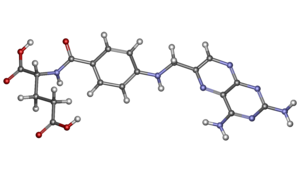Aminopterin
 |
|
 |
|
| Names | |
|---|---|
|
IUPAC name
2-[ [4-{[(2,4-Diaminopteridin-6-yl)methyl]amino}benzoyl]amino]pentanedioic acid
|
|
| Other names
4-Aminofolic acid
4-Aminopteroylglutamic acid Aminopterin sodium Aminopteroylglutamic acid |
|
| Identifiers | |
|
3D model (Jmol)
|
|
| ChemSpider | |
| ECHA InfoCard | 100.000.191 |
| EC Number | 200-209-9 |
|
PubChem CID
|
|
| UNII | |
|
|
|
|
| Properties | |
| C19H20N8O5 | |
| Molar mass | 440.41 g/mol |
|
Except where otherwise noted, data are given for materials in their standard state (at 25 °C [77 °F], 100 kPa).
|
|
|
|
|
| Infobox references | |
Aminopterin (or 4-aminopteroic acid), the 4-amino derivative of folic acid, is an antineoplastic drug with immunosuppressive properties often used in chemotherapy. Aminopterin is a synthetic derivative of pterin. Aminopterin works as an enzyme inhibitor by competing for the folate binding site of the enzyme dihydrofolate reductase. Its binding affinity for dihydrofolate reductase effectively blocks tetrahydrofolate synthesis. This results in the depletion of nucleotide precursors and inhibition of DNA, RNA, and protein synthesis.
It is classified as an extremely hazardous substance in the United States as defined in Section 302 of the U.S. Emergency Planning and Community Right-to-Know Act (42 U.S.C. 11002), and is subject to strict reporting requirements by facilities which produce, store, or use it in significant quantities.
Discovered by Dr. Yellapragada Subbarow, the drug was first used by Sidney Farber in 1947 to induce remissions among children with leukemia. Aminopterin was later marketed by Lederle Laboratories (Pearl River, New York) in the United States from 1953 to 1964 for the indication of pediatric leukemia. The closely related antifolate methotrexate was simultaneously marketed by the company during the same period. Aminopterin was discontinued by Lederle Laboratories in favor of methotrexate due to manufacturing difficulties of the former.
During the period Aminopterin was marketed, the agent was used off-label to safely treat over 4,000 patients with psoriasis in the United States, producing dramatic clearing of lesions.
...
Wikipedia
